Petrogenesis of the Late Carboniferous Trondhjemite in Central Inner Mongolia in North China and Constraints of Intra-Oceanic Subduction in the Southern Paleo-Asian Ocean
Abstract
:1. Introduction
2. Geological Setting
3. Field Relationship and Petrography
4. Analytical Methods
5. Analytical Results
5.1. Major and Trace-Element Analyses
5.2. U-Pb Zircon Ages
6. Discussion
6.1. Petrogenesis of the Trondhjemite
6.2. Tectonic Implications of the Trondhjemite: Constraints of Intra-Oceanic Subduction in the Southern Paleo-Asian Ocean
7. Conclusions
- (1)
- The petrological and geochemical characteristics indicated that the Gaolihan trondhjemite belonged to the tonalite–trondhjemite–granodiorite (TTG) series and formed via melting of the subducted oceanic crust.
- (2)
- The Gaolihan trondhjemite crystallized at 309.2 ± 2.1 Ma, reflecting the subduction-related TTG-type granitoid magmatism and indicating that the southern Paleo-Asian Ocean was in the process of subduction, TTG magmatism, and juvenile continental crust formation in the Late Carboniferous.
Author Contributions
Funding
Data Availability Statement
Conflicts of Interest
References
- Foley, S.F.; Buhre, S.; Jacob, D.E. Evolution of the Archaean crust by delamination and shallow subduction. Nature 2003, 421, 249–252. [Google Scholar] [CrossRef]
- Rapp, R.P.; Shimizu, N.; Norman, M.D. Growth of early continental crust by partial melting of eclogite. Nature 2003, 425, 605–609. [Google Scholar] [CrossRef] [PubMed]
- Foley, S.F.; Tiepolo, M.; Vannucci, R. Growth of early continental crust controlled by melting of amphibolite in subduction zones. Nature 2002, 417, 837–840. [Google Scholar] [CrossRef] [PubMed]
- Rapp, R.P.; Watson, E.B. Dehydration melting of metabasalt at 8~32 kbar: Implications for continental growth and crust mantle recycling. J. Petrol. 1995, 36, 891–931. [Google Scholar] [CrossRef]
- Martin, H.; Smithies, R.H.; Rapp, R.; Moyen, J.F. An overview of adakite, tonalite-trondhjemite-granodiorite (TTG), and sanukitoid: Relationships andsome implications for crustal evolution. Lithos 2005, 79, 1–24. [Google Scholar] [CrossRef]
- Condie, K.C. TTGs and adakites: Are they both slab melts? Lithos 2005, 80, 33–44. [Google Scholar] [CrossRef]
- Safonova, I. Juvenile versus recycled crust in the Central Asian Orogenic belt: Implications from ocean plate stratigraphy, blueschist belts and intra-oceanic arcs. Gondwana Res. 2017, 47, 6–27. [Google Scholar] [CrossRef]
- Dobretsov, N.L.; Buslov, M.M.; Vernikovsky, V.A. Neoproterozoic to Early Ordovician Evolution of the Paleo-Asian Ocean: Implications to the Break-up of Rodinia. Gondwana Res. 2003, 6, 143–159. [Google Scholar] [CrossRef]
- Khain, E.V.; Bibikova, E.V.; Salnikova, E.B.; Kröner, A.; Gibsher, A.S.; Didenko, A.N.; Degtyarev, K.E.; Fedotova, A.A. The Palaeo-Asian ocean in the Neoproterozoic and early Palaeozoic: New geochronologic data and palaeotectonic reconstructions. Precambrian Res. 2003, 122, 329–358. [Google Scholar] [CrossRef]
- Filippova, I.B.; Bush, V.A.; Didenko, A.N. Middle Paleozoic subduction belts: The leading factor in the formation of the Central Asian fold-and-thrust belt. Rus. J. Earth Sci. 2002, 3, 405–426. [Google Scholar] [CrossRef] [Green Version]
- De Jong, K.; Xiao, W.J.; Windley, B.F.; Masago, H.; Lo, C.H. Ordovician 40Ar/39Ar phengite ages from the blueschist-facies Ondor Sum subduction-accretion complex (Inner Mongolia) and implications for the early Paleozoic history of continental blocks in China and adjacent areas. Am. J. Sci. 2006, 306, 799–845. [Google Scholar] [CrossRef]
- Wilhem, C.; Windley, B.F.; Stampfli, G.M. The Altaids of Central Asia: A tectonic and evolutionary innovative review. Earth Sci. Rev. 2012, 113, 303–341. [Google Scholar] [CrossRef]
- Eizenhöfer, P.R.; Zhao, G.; Zhang, J.; Sun, M. Final closure of the Paleo-Asian Ocean along the Solonker Suture Zone: Constraints from geochronological and geochemical data of Permian volcanic and sedimentary rocks. Tectonics 2014, 33, 441–463. [Google Scholar] [CrossRef]
- Kröner, A. The Central Asian Orogenic Belt–Present knowledge and comparison with the SW Pacific. In The Central Asian Orogenic Belt—Geology, Evolution, Tectonics, and Models. Contributions to the Regional Geology of the Earth; Kröner, A., Ed.; Borntraeger Science Publishers: Stuttgart, Germany, 2015; p. 313. [Google Scholar]
- Xiao, W.; Windley, B.F.; Sun, S.; Li, J.; Huang, B.; Han, C.; Yuan, C.; Sun, M.; Chen, H. A Tale of Amalgamation of Three Permo-Triassic Collage Systems in Central Asia: Oroclines, Sutures, and Terminal Accretion. Ann. Rev. Earth Planet. Sci. 2015, 43, 477–507. [Google Scholar] [CrossRef]
- Jahn, B.M.; Windley, B.; Natal′in, B.; Dobretsov, N. Phanerozoic continental growth in Central Asia. J. Asian Earth Sci. 2004, 23, 599–603. [Google Scholar] [CrossRef]
- Li, J.Y. Permian geodynamic setting of Northeast China and adjacent regions: Closure of the Paleo-Asian Ocean and subduction of the Paleo-Pacific P1ate. J. Asian Earth Sci. 2006, 26, 207–224. [Google Scholar] [CrossRef]
- Xiao, W.J.; Windley, B.F.; Huang, B.C.; Han, C.M.; Yuan, C.; Chen, H.L.; Li, J.L. End-Permian to mid-Triassic termination of the accretionary processes of the southern Altaids: Implications for the geodynamic evolution, Phanerozoic continental growth, and metallogeny of Central Asia. Int. J. Earth Sci. 2009, 98, 1189–1217. [Google Scholar] [CrossRef]
- Windley, B.F.; Alexeiev, D.; Xiao, W.L.; Kröner, A.; Badarch, G. Tectonic models for accretion of the Central Asian Orogenic Belt. J. Geol. Soc. 2007, 164, 31–47. [Google Scholar] [CrossRef]
- Xiao, W.J.; Song, D.F.; Windley, B.F.; Li, J.L.; Han, C.M.; Wan, B.; Zhang, J.E.; Ao, S.J.; Zhang, Z.Y. Research progresses of the accretionary processes and metallogenesis of the Central Asian Orogenic Belt. Sci. China Earth Sci. 2019, 49, 1512–1545, (In Chinese with English Abstract). [Google Scholar]
- Li, Y.J.; Wang, G.H.; Santosh, M.; Wang, J.F.; Li, H.Y. Subduction initiation of the SE Paleo-Asian Ocean: Evidence from a well preserved intra-oceanic forearc ophiolite fragment in central Inner Mongolia. Earth Planet. Sci. Lett. 2020, 535, 116087. [Google Scholar] [CrossRef]
- Xiao, W.J.; Windley, B.F.; Hao, J.; Zhai, M.G. Accretion leading to collision and the Permian Solonker suture, Inner Mongolia, China: Termination of the central Asian orogenic belt. Tectonics 2003, 22, 1069. [Google Scholar] [CrossRef] [Green Version]
- Jian, P.; Liu, D.Y.; Kröner, A.; Windley, B.F.; Shi, Y.R.; Zhang, W.; Zhang, F.Q.; Miao, L.C.; Zhang, L.Q.; Tomurhuu, D. Evolution of a Permian intraoceanic arc-trench system in the Solonker suture zone, Central Asian Orogenic Belt, China and Mongolia. Lithos 2010, 118, 169–190. [Google Scholar] [CrossRef]
- Xu, B.; Charvet, J.; Chen, Y.; Zhao, P.; Shi, G.Z. Middle Paleozoic convergent orogenic belts in western Inner Mongolia (China): Framework, kinematics geochronology and implications for tectonic evolution of the Central Asian Orogenic Belt. Gondwana Res. 2013, 23, 1342–1364. [Google Scholar] [CrossRef]
- Reagan, M.K.; Ishizuka, O.; Stern, R.J.; Kelley, K.A.; Ohara, Y.; Blichert-Toft, J.; Bloomer, S.H.; Cash, J.; Fryer, P.; Hanan, B.B.; et al. Fore-arc basalts and subduction initiation in the Izu-Bonin-Mariana system. Geochem. Geophys. Geosyst. 2010, 11, Q03X12. [Google Scholar] [CrossRef]
- Wang, Q.; Liu, X.Y. Paleoplate tectonics between Cathaysia and Angaral in Inner Mongolia of China. Tectonics 1986, 5, 1073–1088. [Google Scholar] [CrossRef]
- Song, S.G.; Wang, M.M.; Xu, X.; Wang, C.; Niu, Y.; Allen, M.B.; Su, L. Ophiolites in the Xing’an-Inner Mongolia accretionary belt of the CAOB: Implications for two cycles of seafloor spreading and accretionary orogenic events. Tectonics 2015, 34, 2221–2248. [Google Scholar] [CrossRef]
- Nozaka, T.; Liu, Y. Petrology of the Hegenshan ophiolite and its implications for the tectonic evolution of northern China. Earth Planet. Sci. Lett. 2002, 202, 89–104. [Google Scholar] [CrossRef]
- Robinson, P.T.; Bai, W.J.; Yang, J.S.; Hu, X.F.; Zhou, M.F. Geochemical constraints on petrogenesis and crustal accretion of the Hegenshan ophiolite, northern China. Acta Petrol. Sin. 1995, 11, 112–124, (In Chinese with English Abstract). [Google Scholar]
- Li, Y.J.; Wang, G.H.; Santosh, M.; Wang, J.F.; Dong, P.P.; Li, H.Y. Suprasubduction zone ophiolites from Inner Mongolia, North China: Implications for the tectonic history of the southeastern Central Asian Orogenic Belt. Gondwana Res. 2018, 59, 126–143. [Google Scholar] [CrossRef]
- Li, Y.J.; Wang, J.F.; Li, H.Y.; Dong, P.P. Recognition of Meilaotewula ophiolite in Xi U jimqin Banner, Inner Mongolia. Acta Petrol. Sin. 2015, 31, 1461–1470, (In Chinese with English Abstract). [Google Scholar]
- Li, Y.J.; Wang, J.F.; Xin, H.T.; Dong, P.P. Subduction initiation in the southeastern Palaeo-Asian Ocean: Constraints from early Permian adakites in suprasubduction zone ophiolites, central Inner Mongolia, North China. Geol. J. 2020, 55, 2044–2061. [Google Scholar] [CrossRef]
- Eizenhöfer, P.R.; Zhao, G.; Sun, M.; Zhang, J.; Han, Y.G.; Hou, W. Geochronological and Hf isotopic variability of detrital zircons in Paleozoic strata across the accretionary collision zone between the North China craton and Mongolian arcs and tectonic implications. Geol. Soc. Am. Bull. 2015, 127, 1422–1436. [Google Scholar] [CrossRef]
- Jian, P.; Kröner, A.; Windley, B.F.; Shi, Y.R.; Zhang, W.; Zhang, L.Q.; Yange, W.R. Carboniferous and Cretaceous mafic-ultramafic massifs in Inner Mongolia (China): A SHRIMP zircon and geochemical study of the previously presumed integral “Hegenshan ophiolite”. Lithos 2012, 142–143, 48–66. [Google Scholar] [CrossRef]
- Wang, S.Q.; Hu, X.J.; Yang, Z.L.; Zhao, H.L.; Zhang, Y.; Hao, S.; He, L. Geochronology, Geochemistry, Sr-Nd-Hf Isotopic Characteristics and Geological Significance of Carboniferous Yuejin Arc Intrusive Rocks of Xilinhot, Inner Mongolia. Earth Sci. 2018, 43, 1–31. [Google Scholar]
- Xue, J.P.; Liu, M.Y.; Li, G.Z.; Zhao, G.M. Zircon geochronology and geochemistry of Haer Bogetuoer TTG rock, Solonker zone, Inner Mongolia and their tectonic implications. Earth Sci. Front. 2018, 25, 230–239. [Google Scholar]
- Ishizuka, O.; Tani, K.; Reagan, M.K. Izu-Bonin-Mariana forearc crust as a modern ophiolite analogue. Elements 2014, 10, 115–120. [Google Scholar] [CrossRef]
- Liu, Y.S.; Gao, S.; Hu, Z.C.; Gao, C.G.; Zong, K.Q.; Wang, D.B. Continental and oceanic crust recycling-induced melt-peridotite interactions in the Trans-North China Orogen: U-Pb dating, Hf isotopes and trace elements in zircons of mantle xenoliths. J. Petrol. 2010, 51, 537–571. [Google Scholar] [CrossRef]
- Ludwig, K.R. ISOPLOT 3.00: A Geochronological Toolkit for Microsoft Excel; Berkeley Geochronology Center: Berkeley, CA, USA, 2003; 39p. [Google Scholar]
- Fan, Y.X. The composition and evolution of the late Paleozoic inner-oceanic arc in Xiwuqi, Inner Mongolia. Chin. Acad. Geol. Sci. 2019, 1–137. [Google Scholar]
- Wang, J.F.; Li, Y.J.; Li, H.Y.; Dong, P.P. Discovery of the Late Carboniferous adakite in the Erenhot-Hegenshan suture zone and intra-oceanic subduction of the Paleo-Asian Ocean. Geol. China 2021, 48, 520–535, (In Chinese with English Abstract). [Google Scholar]
- Bach, W.; Alt, J.C.; Niu, Y.L.; Humphris, S.E.; Erzinger, J.; Dick, H.J. The geochemical consequences of late-stage low-grade alteration of lower ocean crust at the SW Indian Ridge: Results from ODP Hole 735B (Leg 176). Geochim. Cosmochim. Acta 2001, 65, 3267–3287. [Google Scholar] [CrossRef]
- O’Connor, J.T. A classification for quartz-rich igneous rocks based on feldspar ratios. U.S. Geol. Surv. Prof. Pap. 1965, 525-B, 79–84. [Google Scholar]
- Barker, F.; Arth, J.G. Generation of trondhjemitic-tonalitic liquids and Archaean bimodal trondhjemite-basalt suites. Geology 1976, 4, 596–600. [Google Scholar] [CrossRef]
- Le Bas, M.J.; Maiter, R.W.; Streckeisen, A.; Zanettin, B. A chemical classification of volcanic rocks based on the total alkali-silica diagram. J. Petrol. 1986, 27, 745–750. [Google Scholar] [CrossRef]
- Peccerillo, A.; Taylor, S.R. Geochemistry of Eocene calc-alkaline volcanic rocks from the Kastamonu area, northern Turkey. Contrib. Mineral. Petrol. 1976, 58, 63–81. [Google Scholar] [CrossRef]
- Sun, S.S.; McDonough, W.F. Chemical and isotopic systematics of oceanic basalts: Implications for mantle composition and processes. In Magmatism in the Ocean Basins; Saunders, A.D., Norry, M.J., Eds.; Geological Society of London, Special Publication: London, UK, 1989; Volume 42, pp. 313–345. [Google Scholar]
- Wang, S.; Li, Y.J.; Wang, J.F.; Dong, P.P.; Li, H.Y.; Guo, L.L.; Wang, X.C. Discovery of Late Carboniferous adakite in Manita, Inner Mongolia, and its constrains on intra-oceanic subduction in eastern Paleo-Asian Ocean. Geol. Bull. China 2021, 40, 82–94, (In Chinese with English Abstract). [Google Scholar]
- Defant, M.J.; Drummond, M.S. Derivation of some modern arc magmas by melting of young subducted lithosphere. Nature 1990, 347, 662–665. [Google Scholar] [CrossRef]
- Kelemen, P.B.; Hangh, K.; Ureenem, A.R. One view of the geochemistry of subduction-related magmatic arcs, with an emphasis on primitive andesite and lower crust. In Treatise on Geochemistry; Rudnick, R.L., Ed.; Elsevier: Amsterdam, The Netherlands, 2003; Volume 3, pp. 593–659. [Google Scholar]
- Hoskin, P.W.O.; Schaltegger, U. The composition of zircon and igneous and metamorphic petrogenesis. Rev. Mineral. Geochem. 2003, 53, 27–62. [Google Scholar] [CrossRef]
- Azizi, H.; Zanjefifili Beiranvand, M.; Asahara, Y. Zircon U-Pb ages and petrogenesis of a tonalite–trondhjemite–granodiorite (TTG) complex in the northern Sanandaj–Sirjan Zone, northwest Iran: Evidence for Late Jurassic arc–continent collision. Lithos 2014, 216–217, 178–195. [Google Scholar] [CrossRef]
- Prouteau, G.; Scaillet, B.; Pichavant, M.; Maury, R.C. Evidence for mantle metasomatism by hydrous silicic melts derived from subducted oceanic crust. Nature 2001, 410, 197–200. [Google Scholar] [CrossRef] [PubMed] [Green Version]
- Rudnick, R.L. Making continental crust. Nature 1995, 378, 571–577. [Google Scholar] [CrossRef]
- Albare`de, F. The growth of continental crust. Tectonophysics 1998, 296, 1–14. [Google Scholar] [CrossRef]
- Smithies, R.H. The Archaean tonalite-trondhjemite-granodiorite (TTG) series is not an an alogue of Cenozoic adakite. Earth Planet. Sci. Lett. 2000, 182, 115–125. [Google Scholar] [CrossRef]
- Gutscher, M.A.; Spakman, W.; Bijward, H.; Engdahl, E.R. Geodynamics of flat subduction: Seismicity and tomographic evidence from the Andean margin. Tectonics 2000, 19, 814–833. [Google Scholar] [CrossRef]
- Pearce, J.A.; Lippard, S.J.; Roberts, S. Characteristics and tectonic significance of supra-subduction zone ophiolites. In Marginal Basin Geology; Kokelaar, B.P., Howells, M.F., Eds.; Geological Society of London, Special Publication: London, UK, 1984; Volume 16, pp. 77–94. [Google Scholar]
- Martin, H. Adakitic magmas: Modern analogues of Archaean granitoids. Lithos 1999, 46, 411–429. [Google Scholar] [CrossRef]
- Pearce, J.A.; Peate, D.W. Tectonic implications of the composition of volcanic arc magma. Ann. Rev. Earth Planet. Sci. 1995, 23, 251–285. [Google Scholar] [CrossRef]
- Thorkelson, D.J.; Breitsprecher, K. Partial melting of slab window margins: Genesis of adakitic and non-adakitic magmas. Lithos 2005, 79, 24–41. [Google Scholar] [CrossRef]
- Viruete, J.E.; Contreras, F.; Stein, C. Magmatic relationships and ages between adakites, magnesian andesites and Nb-enriched basalt-andesites from Hipaniola: Record of a major change in the Caribbean island arc magma sources. Lithos 2007, 99, 151–177. [Google Scholar] [CrossRef]
- Martin, H.; Moyen, J.F. Secular changes in tonalite-trondhjemite-granodiorite composition as markers of the progressive cooling of Earth. Geology 2002, 30, 319–322. [Google Scholar] [CrossRef]
- Şengör, A.M.C.; Natalin, B.A.; Burtman, V.S. Evolution of the Altaid tectonic collage and Paleozoic crustal growth in Eurasia. Nature 1993, 364, 299–307. [Google Scholar] [CrossRef]
- Reagan, M.K.; Pearce, J.A.; Petronotis, K.; Almeev, R.; Avery, A.J.; Carvallo, C.; Whattam, S.A. Subduction initiation and ophioite crust: New insights from IODP drilling. Int. Geol. Rev. 2017, 59, 1439–1450. [Google Scholar] [CrossRef]
- Stern, R.J.; Gerya, T. Subduction initiation in nature and models: A review. Tectonophysics 2018, 746, 173–198. [Google Scholar] [CrossRef]
- Li, H.Y.; Taylor, R.N.; Prytulak, J.; Kirchenbaur, M.; Shervais, J.W.; Ryan, J.G.; Godard, M.; Reagan, M.K.; Pearce, J.A. Radiogenic isotopes document the start of subduction in the Western Pacific. Earth Planet. Sci. Lett. 2019, 518, 197–210. [Google Scholar] [CrossRef]
- Whattam, S.A.; Stern, R.J. The ‘subduction initiation rule’: A key for linking ophiolites, intra-oceanic forearcs, and subduction initiation. Contribut. Mineral. Petrol. 2011, 162, 1031–1045. [Google Scholar] [CrossRef]
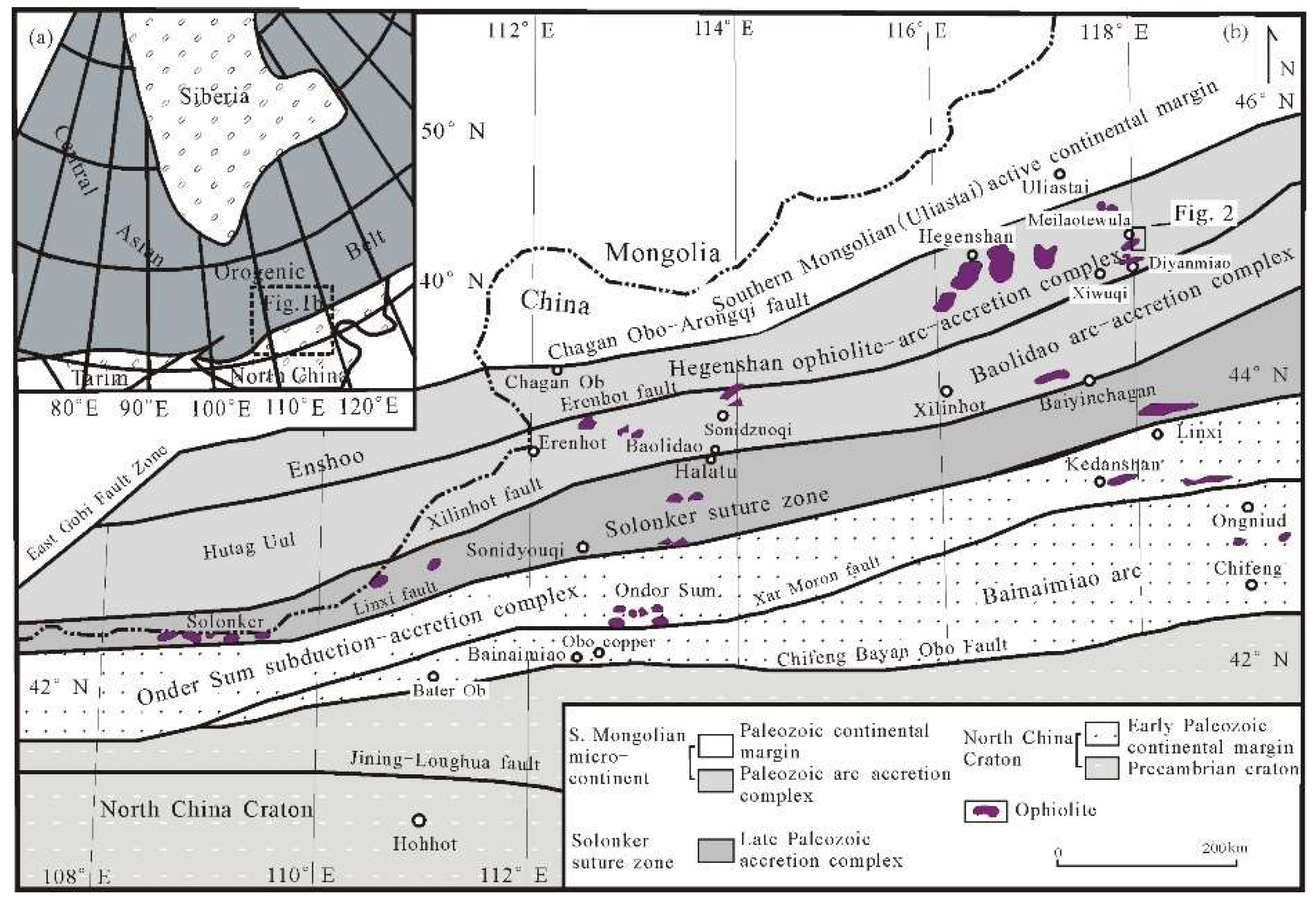
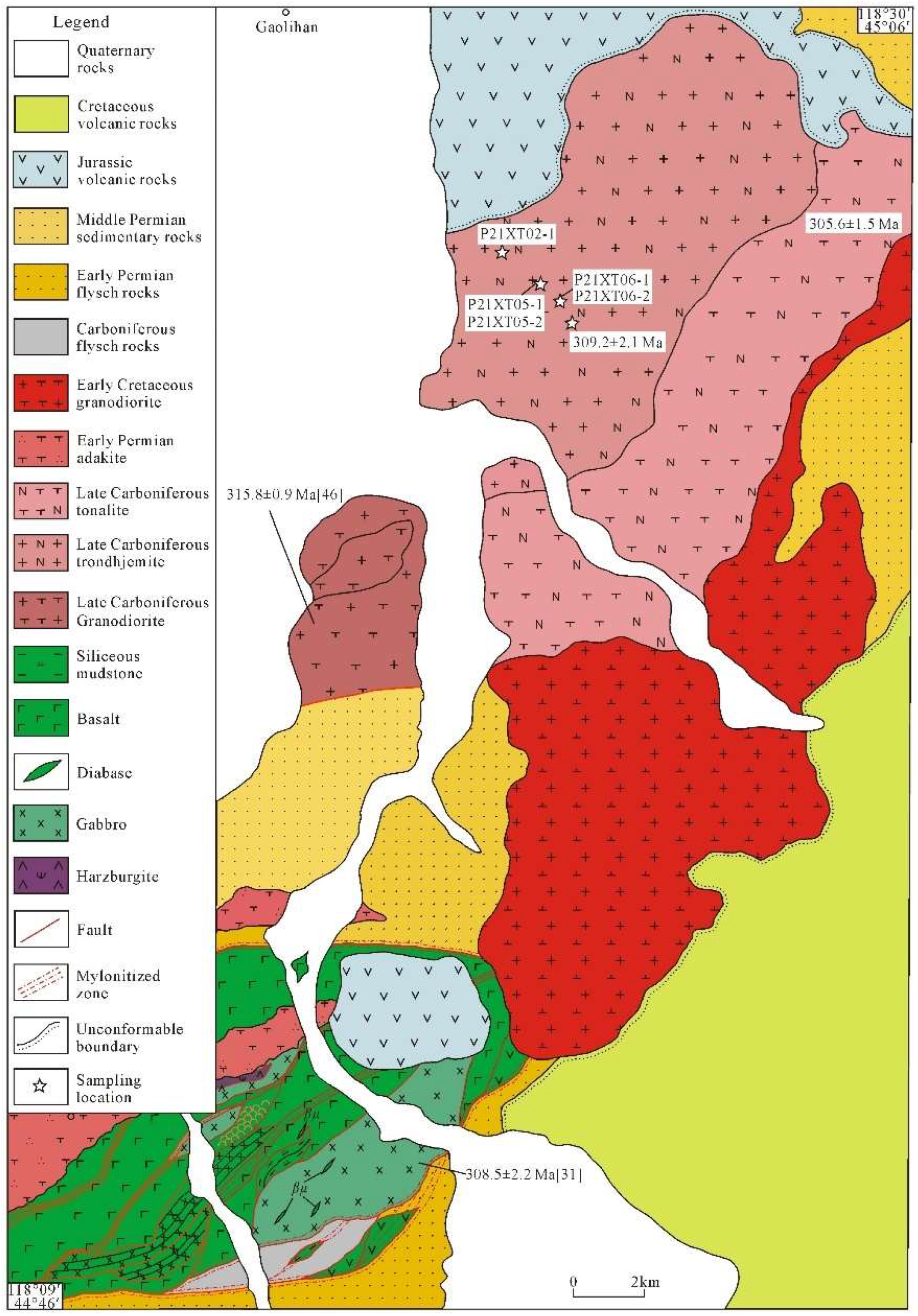
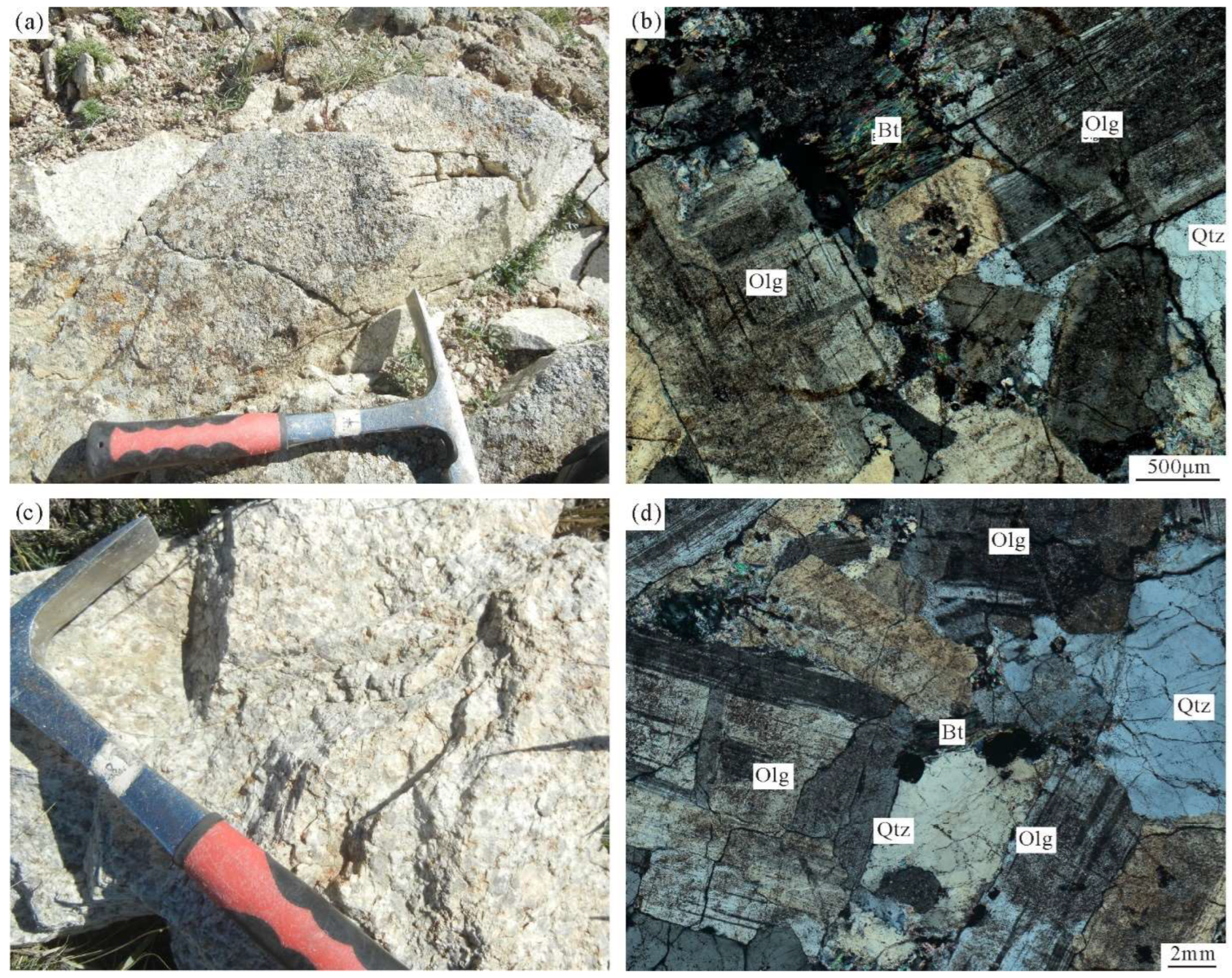
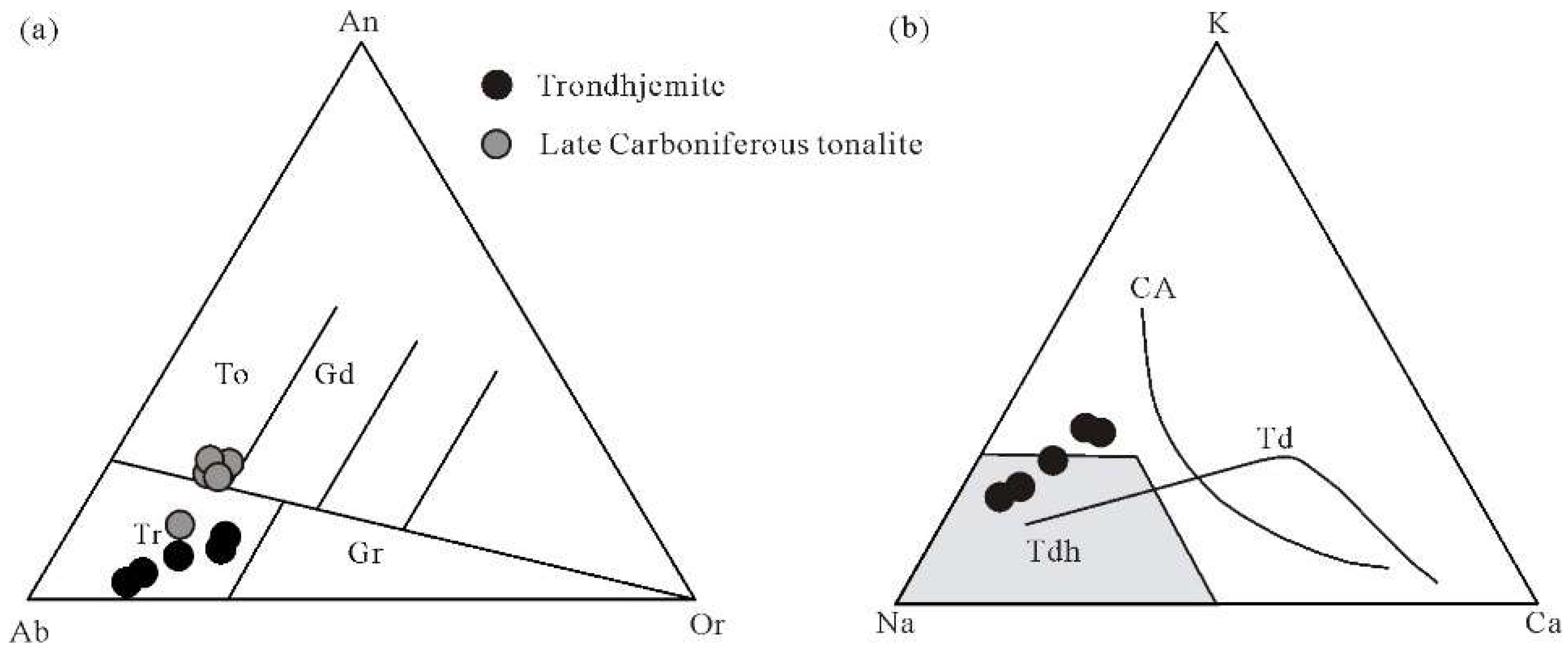

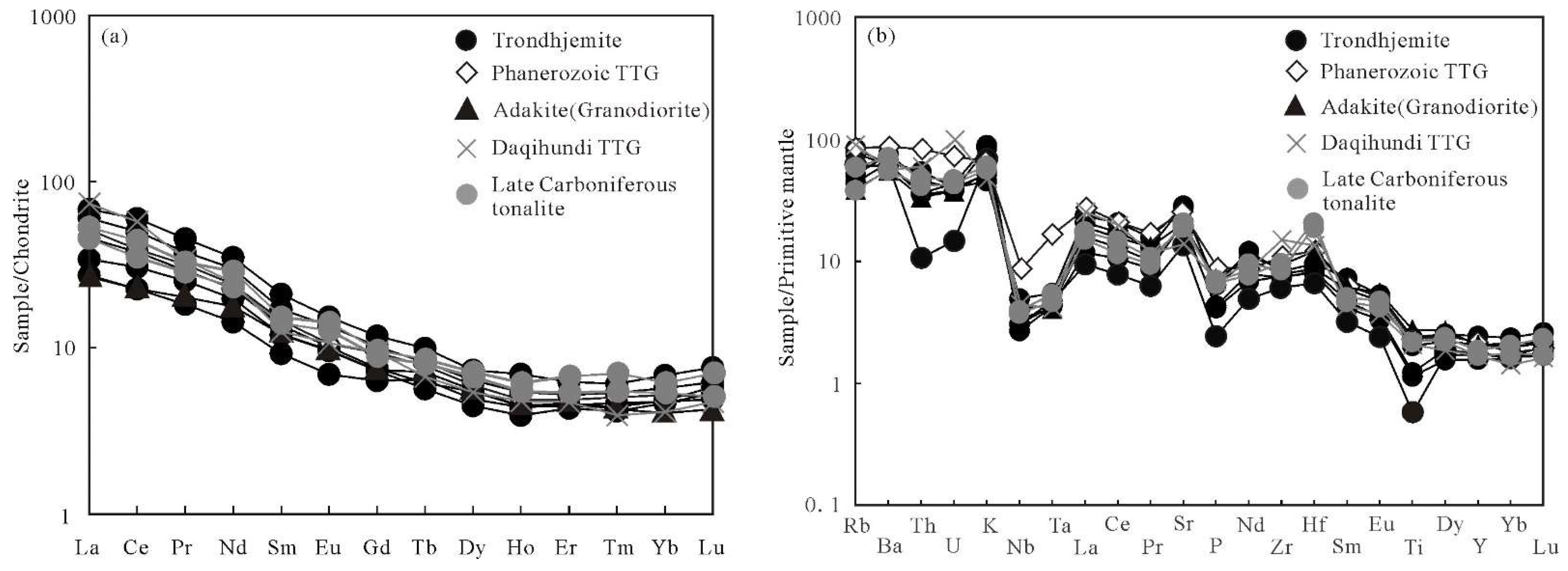
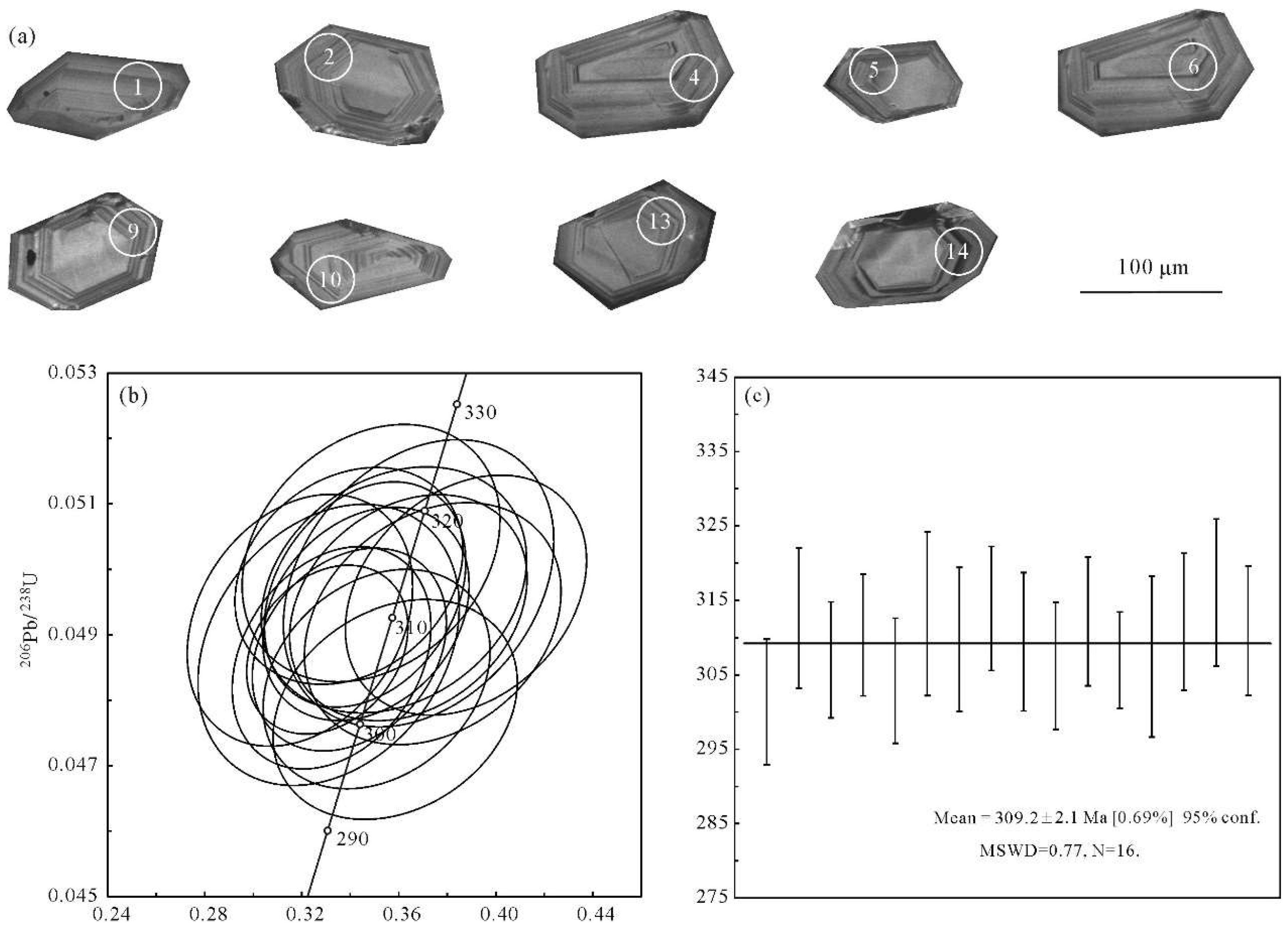
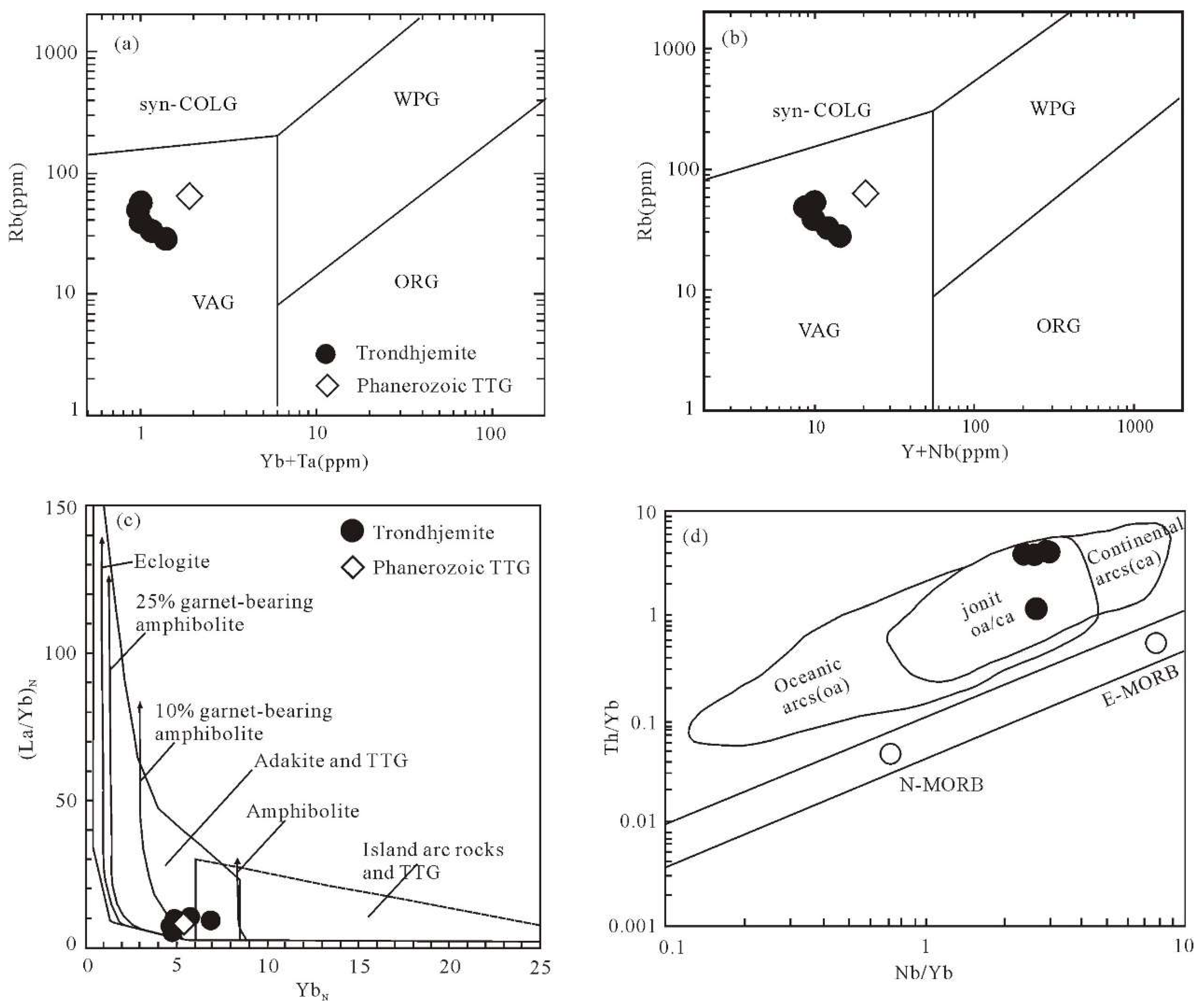
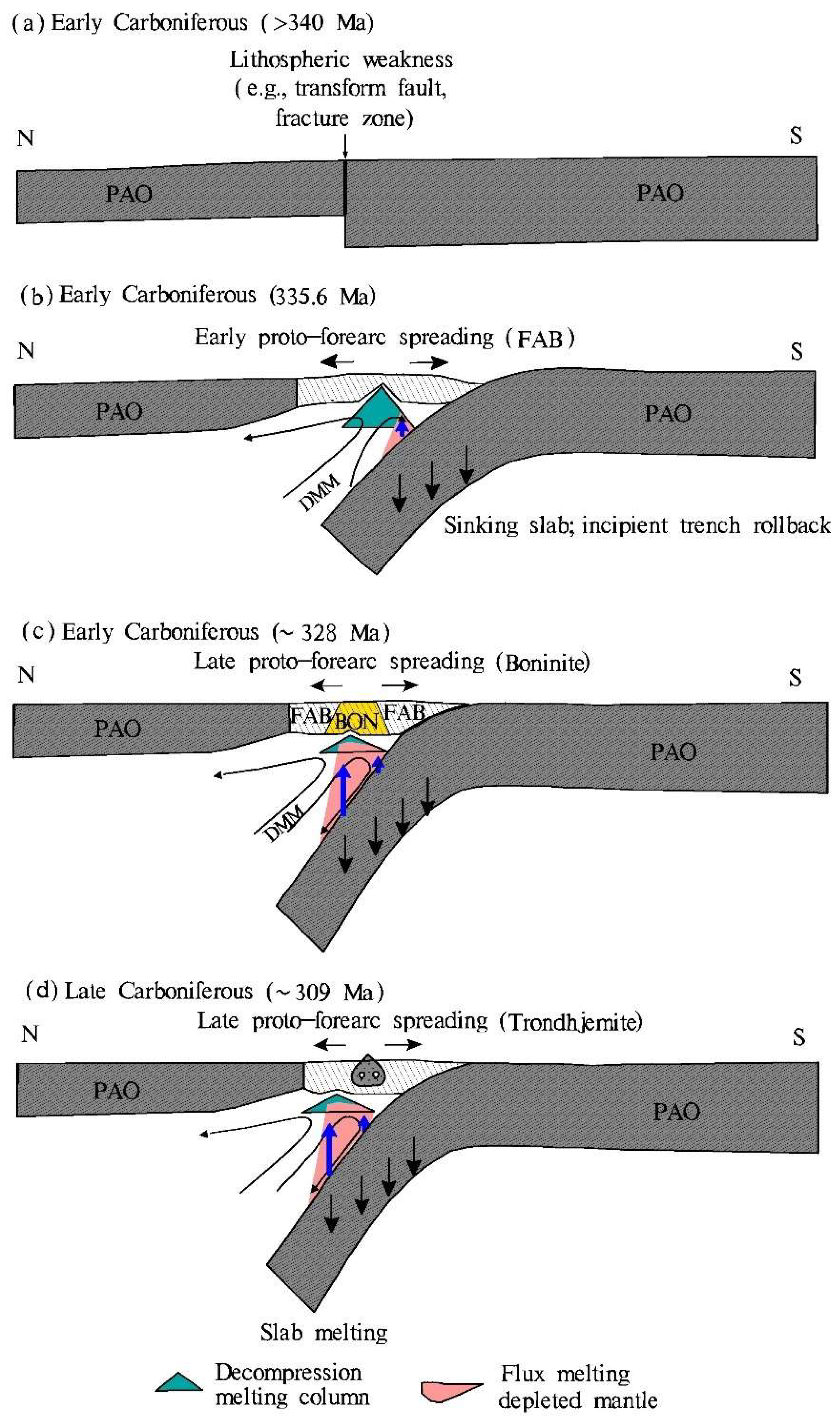
| Sample | P21XT02-1 | P21XT05-1 | P21XT05-2 | P16XT06-1 | P16XT06-2 | Phanerozoic TTG | TTG Rock in the Central Asian Orogenic Belt | Late Carboniferous Tonalite | |||||
|---|---|---|---|---|---|---|---|---|---|---|---|---|---|
| Major element (wt %) a | |||||||||||||
| SiO2 | 72.58 | 68.94 | 69.24 | 71.81 | 71.30 | 65.90 | 69.05 | 69.20 | 64.46 | 77.17 | 71.10 | 66.58 | 66.45 |
| TiO2 | 0.12 | 0.44 | 0.52 | 0.25 | 0.27 | 0.47 | 0.30 | 0.31 | 0.65 | 0.23 | 0.45 | 0.50 | 0.49 |
| Al2O3 | 15.55 | 15.90 | 15.83 | 14.85 | 15.23 | 16.50 | 13.87 | 13.19 | 15.72 | 11.23 | 13.85 | 15.57 | 16.14 |
| TFe2O3 | 1.24 | 3.17 | 3.38 | 2.01 | 2.05 | 1.56 | 3.41 | ||||||
| MnO | 0.06 | 0.05 | 0.05 | 0.06 | 0.05 | 0.09 | 0.09 | 0.08 | 0.11 | 0.14 | 0.04 | 0.07 | 0.07 |
| MgO | 0.36 | 1.24 | 1.33 | 0.76 | 0.77 | 1.67 | 1.11 | 1.25 | 2.20 | 0.56 | 1.17 | 1.64 | 1.94 |
| CaO | 1.11 | 0.78 | 0.56 | 1.54 | 1.32 | 4.36 | 3.72 | 2.37 | 4.82 | 2.56 | 2.58 | 3.39 | 2.90 |
| Na2O | 5.73 | 5.91 | 5.99 | 4.80 | 5.13 | 4.00 | 4.08 | 4.11 | 3.65 | 3.84 | 3.78 | 4.25 | 4.45 |
| K2O | 2.08 | 1.57 | 1.37 | 2.55 | 2.70 | 2.14 | 1.65 | 2.78 | 1.72 | 0.89 | 1.44 | 1.91 | 1.81 |
| P2O5 | 0.05 | 0.14 | 0.14 | 0.09 | 0.09 | 0.12 | 0.09 | 0.08 | 0.21 | 0.04 | 0.15 | 0.15 | 0.16 |
| Total b | 99.94 | 99.83 | 99.94 | 99.80 | 100.05 | 97.9 | 98.35 | 99.67 | 100.09 | 99.97 | 99.83 | 99.88 | |
| LOI | 1.06 | 1.69 | 1.55 | 1.08 | 1.14 | 2.11 | 1.95 | ||||||
| Mg # | 40.34 | 47.62 | 47.73 | 46.92 | 46.71 | 41.79 | 46 | 51 | |||||
| Trace element (ppm) | |||||||||||||
| Rb | 38.50 | 32.60 | 28.10 | 48.60 | 53.10 | 63.00 | 30.02 | 50.94 | 59.50 | 6.83 | 57.42 | 39.80 | 25.70 |
| Cr | 1.55 | 4.94 | 5.42 | 3.93 | 3.83 | 32.00 | 3.48 | 3.90 | 9.88 | 2.85 | 3.01 | 11.50 | 12.30 |
| Co | 1.26 | 6.40 | 7.15 | 3.58 | 3.64 | 40.70 | 4.51 | 6.00 | 13.5 | 1.62 | 6.65 | 10.60 | 9.30 |
| Ni | 1.10 | 4.19 | 5.74 | 2.82 | 2.33 | 12.00 | 2.65 | 2.03 | 5.14 | 3.07 | 4.00 | 6.20 | 5.90 |
| Sc | 1.67 | 5.41 | 5.85 | 3.61 | 4.00 | 34.90 | 7.16 | 7.16 | 7.88 | 6.12 | |||
| V | 11.40 | 62.00 | 62.50 | 34.70 | 36.70 | 243.00 | 75.94 | 79.10 | 13.56 | 90.50 | 67.50 | ||
| Zr | 68.10 | 87.90 | 92.40 | 84.10 | 82.00 | 122.00 | 118.60 | 96.84 | 156.00 | 45.86 | 168.37 | 113.20 | 99.40 |
| Hf | 2.04 | 2.68 | 2.96 | 2.47 | 2.56 | 3.40 | 3.61 | 3.22 | 4.28 | 1.37 | 4.18 | 7.00 | 7.52 |
| Ta | 0.19 | 0.18 | 0.23 | 0.18 | 0.18 | 0.75 | 0.19 | 0.19 | 0.44 | 0.03 | 0.17 | 0.20 | 0.23 |
| Sr | 286.00 | 601.00 | 586.00 | 439.00 | 412.00 | 493.00 | 207.60 | 143.74 | 336.00 | 71.82 | 293.56 | 458.60 | 421.20 |
| Ba | 426.00 | 527.00 | 452.00 | 427.00 | 432.00 | 716.00 | 354.80 | 444.20 | 359.00 | 59.77 | 394.60 | 528.20 | 413.20 |
| Nb | 2.17 | 2.89 | 3.51 | 1.91 | 2.19 | 6.70 | 2.21 | 2.22 | 6.27 | 0.33 | 3.16 | 2.78 | 2.93 |
| Cs | 0.79 | 2.38 | 2.04 | 1.09 | 0.96 | 0.44 | 0.81 | 3.76 | |||||
| Ga | 17.10 | 17.80 | 17.50 | 18.30 | 18.20 | 14.37 | 15.94 | ||||||
| Th | 0.91 | 3.90 | 4.62 | 3.00 | 3.07 | 7.60 | 2.97 | 3.26 | 4.78 | 0.59 | 5.09 | 4.29 | 3.73 |
| U | 0.31 | 0.83 | 0.85 | 0.80 | 0.91 | 1.90 | 0.73 | 3.47 | 1.04 | 0.16 | 2.09 | 1.04 | 0.95 |
| La | 6.48 | 14.30 | 16.20 | 8.10 | 10.80 | 17.00 | 5.69 | 7.19 | 17.80 | 7.44 | 17.48 | 10.89 | 12.67 |
| Ce | 13.90 | 30.70 | 36.80 | 18.70 | 23.10 | 34.00 | 13.31 | 14.42 | 36.20 | 21.13 | 35.16 | 21.62 | 27.35 |
| Pr | 1.73 | 3.59 | 4.32 | 2.41 | 2.78 | 1.75 | 2.04 | 4.70 | 2.50 | 3.22 | 2.73 | 3.13 | |
| Nd | 6.68 | 14.00 | 16.30 | 9.25 | 10.70 | 16.00 | 7.90 | 8.74 | 19.20 | 10.02 | 11.54 | 10.90 | 13.58 |
| Sm | 1.42 | 2.62 | 3.23 | 1.83 | 2.09 | 3.10 | 2.18 | 2.24 | 4.06 | 2.61 | 1.92 | 2.16 | 2.35 |
| Eu | 0.40 | 0.79 | 0.89 | 0.56 | 0.59 | 0.84 | 0.71 | 0.68 | 1.10 | 0.47 | 0.62 | 0.74 | 0.83 |
| Gd | 1.30 | 2.10 | 2.42 | 1.50 | 1.56 | 2.80 | 2.60 | 2.54 | 4.44 | 2.56 | 1.94 | 1.83 | 1.99 |
| Tb | 0.24 | 0.31 | 0.37 | 0.21 | 0.23 | 0.40 | 0.44 | 0.41 | 0.62 | 0.25 | 0.30 | 0.32 | |
| Dy | 1.25 | 1.62 | 1.87 | 1.14 | 1.39 | 3.28 | 2.94 | 3.86 | 3.09 | 1.37 | 1.71 | 1.82 | |
| Ho | 0.25 | 0.31 | 0.39 | 0.22 | 0.25 | 0.66 | 0.58 | 0.80 | 0.66 | 0.27 | 0.31 | 0.35 | |
| Er | 0.75 | 0.86 | 1.04 | 0.72 | 0.74 | 2.27 | 2.00 | 2.26 | 1.97 | 0.78 | 0.89 | 1.12 | |
| Tm | 0.12 | 0.14 | 0.16 | 0.11 | 0.11 | 0.34 | 0.30 | 0.35 | 0.31 | 0.10 | 0.14 | 0.18 | |
| Yb | 0.81 | 0.98 | 1.16 | 0.79 | 0.82 | 1.16 | 2.64 | 2.40 | 2.54 | 2.19 | 0.70 | 0.91 | 1.05 |
| Lu | 0.12 | 0.16 | 0.19 | 0.14 | 0.15 | 0.18 | 0.40 | 0.36 | 0.36 | 0.35 | 0.12 | 0.13 | 0.18 |
| Y | 7.84 | 9.39 | 11.1 | 7.12 | 7.90 | 14.50 | 17.04 | 14.69 | 20.10 | 20.54 | 7.66 | 7.86 | 8.84 |
| Total REE | 35.43 | 72.51 | 85.41 | 45.74 | 55.33 | 44.17 | 46.83 | 98.29 | 55.73 | 75.47 | 55.26 | 66.89 | |
| LREE | 30.58 | 66.04 | 77.80 | 40.91 | 50.08 | ||||||||
| HREE | 4.85 | 6.47 | 7.61 | 4.83 | 5.25 | ||||||||
| LREE/HREE | 6.31 | 10.20 | 10.23 | 8.47 | 9.54 | ||||||||
| (La/Yb) N | 5.76 | 10.52 | 9.97 | 7.34 | 9.49 | ||||||||
| δEu | 0.91 | 1.03 | 0.98 | 1.03 | 1.00 | 0.91 | 0.87 | 0.99 | |||||
| Spot No. | Element (ppm) | Th/U | Isotopic Ratios | Apparent Age (Ma) | |||||||||||
|---|---|---|---|---|---|---|---|---|---|---|---|---|---|---|---|
| Th | U | 206Pb/238U | 1σ | 207Pb/235U | 1σ | 207Pb/206Pb | 1σ | 206Pb/238U | 1σ | 207Pb/235U | 1σ | 207Pb/206Pb | 1σ | ||
| P16TW08 Trondhjemite | |||||||||||||||
| 01 | 77 | 125 | 0.62 | 0.0479 | 0.0007 | 0.3585 | 0.0206 | 0.0540 | 0.0030 | 301 | 4 | 311 | 15 | 369 | 131 |
| 02 | 47 | 94 | 0.50 | 0.0497 | 0.0008 | 0.3580 | 0.0224 | 0.0525 | 0.0035 | 313 | 5 | 311 | 17 | 309 | 152 |
| 03 | 98 | 146 | 0.67 | 0.0488 | 0.0006 | 0.3396 | 0.0164 | 0.0505 | 0.0025 | 307 | 4 | 297 | 12 | 217 | 115 |
| 04 | 104 | 161 | 0.64 | 0.0493 | 0.0007 | 0.3465 | 0.0174 | 0.0514 | 0.0027 | 310 | 4 | 302 | 13 | 257 | 86 |
| 05 | 83 | 127 | 0.65 | 0.0483 | 0.0007 | 0.3509 | 0.0191 | 0.0535 | 0.0029 | 304 | 4 | 305 | 14 | 350 | 131 |
| 06 | 48 | 97 | 0.50 | 0.0498 | 0.0009 | 0.3682 | 0.0228 | 0.0536 | 0.0034 | 313 | 5 | 318 | 17 | 367 | 144 |
| 07 | 49 | 99 | 0.49 | 0.0492 | 0.0008 | 0.3192 | 0.0190 | 0.0480 | 0.0030 | 310 | 5 | 281 | 15 | 98.2 | 141 |
| 08 | 71 | 121 | 0.59 | 0.0499 | 0.0007 | 0.3395 | 0.0192 | 0.0494 | 0.0028 | 314 | 4 | 297 | 15 | 165 | 131 |
| 09 | 50 | 98 | 0.51 | 0.0492 | 0.0008 | 0.3740 | 0.0216 | 0.0561 | 0.0035 | 309 | 5 | 323 | 16 | 457 | 134 |
| 10 | 92 | 131 | 0.70 | 0.0486 | 0.0007 | 0.3323 | 0.0168 | 0.0502 | 0.0028 | 306 | 4 | 291 | 13 | 206 | 127 |
| 11 | 100 | 138 | 0.72 | 0.0496 | 0.0007 | 0.3461 | 0.0170 | 0.0512 | 0.0027 | 312 | 4 | 302 | 13 | 250 | 122 |
| 12 | 339 | 241 | 1.41 | 0.0488 | 0.0005 | 0.3305 | 0.0136 | 0.0489 | 0.0020 | 307 | 3 | 290 | 10 | 143 | 94 |
| 13 | 38 | 79 | 0.48 | 0.0488 | 0.0009 | 0.3311 | 0.0220 | 0.0496 | 0.0039 | 307 | 5 | 290 | 17 | 176 | 174 |
| 14 | 68 | 108 | 0.63 | 0.0496 | 0.0007 | 0.3878 | 0.0203 | 0.0571 | 0.0031 | 312 | 5 | 333 | 15 | 494 | 122 |
| 15 | 53 | 106 | 0.50 | 0.0503 | 0.0008 | 0.3486 | 0.0217 | 0.0501 | 0.0033 | 316 | 5 | 304 | 16 | 198 | 156 |
| 16 | 67 | 118 | 0.56 | 0.0494 | 0.0007 | 0.3640 | 0.0200 | 0.0536 | 0.0032 | 311 | 4 | 315 | 15 | 354 | 133 |
Publisher’s Note: MDPI stays neutral with regard to jurisdictional claims in published maps and institutional affiliations. |
© 2022 by the authors. Licensee MDPI, Basel, Switzerland. This article is an open access article distributed under the terms and conditions of the Creative Commons Attribution (CC BY) license (https://creativecommons.org/licenses/by/4.0/).
Share and Cite
Dong, P.; Li, Y.; Xie, Y.; Wang, J.; Li, H. Petrogenesis of the Late Carboniferous Trondhjemite in Central Inner Mongolia in North China and Constraints of Intra-Oceanic Subduction in the Southern Paleo-Asian Ocean. Minerals 2022, 12, 1212. https://doi.org/10.3390/min12101212
Dong P, Li Y, Xie Y, Wang J, Li H. Petrogenesis of the Late Carboniferous Trondhjemite in Central Inner Mongolia in North China and Constraints of Intra-Oceanic Subduction in the Southern Paleo-Asian Ocean. Minerals. 2022; 12(10):1212. https://doi.org/10.3390/min12101212
Chicago/Turabian StyleDong, Peipei, Yingjie Li, Yan Xie, Jinfang Wang, and Hongyang Li. 2022. "Petrogenesis of the Late Carboniferous Trondhjemite in Central Inner Mongolia in North China and Constraints of Intra-Oceanic Subduction in the Southern Paleo-Asian Ocean" Minerals 12, no. 10: 1212. https://doi.org/10.3390/min12101212
APA StyleDong, P., Li, Y., Xie, Y., Wang, J., & Li, H. (2022). Petrogenesis of the Late Carboniferous Trondhjemite in Central Inner Mongolia in North China and Constraints of Intra-Oceanic Subduction in the Southern Paleo-Asian Ocean. Minerals, 12(10), 1212. https://doi.org/10.3390/min12101212





